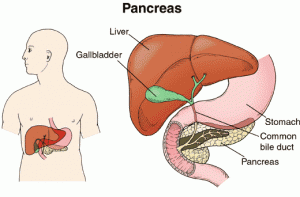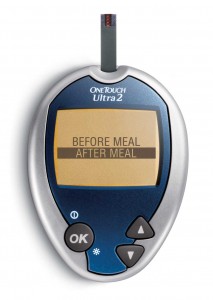Could you have diabetes and not know it?
 Glucose (also known as blood sugar) is produced by the body from the foods that you eat (and some by the liver). The pancreas, an organ located just behind the stomach, produces insulin. Insulin is a hormone that helps to move the sugar from the bloodstream and into your body’s cells where it is used for energy. This process controls the amount of sugar in your blood, keeping it from getting too low or too high.
Glucose (also known as blood sugar) is produced by the body from the foods that you eat (and some by the liver). The pancreas, an organ located just behind the stomach, produces insulin. Insulin is a hormone that helps to move the sugar from the bloodstream and into your body’s cells where it is used for energy. This process controls the amount of sugar in your blood, keeping it from getting too low or too high.
Type 2 diabetes and pre-diabetes occur when the body doesn’t make enough insulin or becomes resistant to the effects of insulin. As a result, sugar levels build up in the bloodstream.
Pre-diabetes is a condition in which your blood sugar level is higher than normal, but not high enough to be classified as type 2 diabetes. Still, the stakes are high. If you have pre-diabetes, the long-term damage of diabetes — especially to your heart and circulatory system — may already be starting.
Each year about 1 out of 10 patients (or 10%) with pre-diabetes develops type 2 diabetes. If left untreated, diabetes can cause blindness, kidney failure, nerve damage, heart disease, stroke, and high blood pressure. Even when blood sugar levels are slightly high, as they are with pre-diabetes, your risk for cardiovascular disease increases.
There’s good news, however. Progression from pre-diabetes to type 2 diabetes isn’t inevitable. With healthy lifestyle changes — such as eating healthy foods, including physical activity in your daily routine and maintaining a healthy weight — you may be able to bring your blood sugar level back to normal.
Symptoms of pre-diabetes & type 2 diabetes
Often, prediabetes has no signs or symptoms. But it’s important to watch for the classic red flags of type 2 diabetes, including:
- Increased thirst
- Frequent drinking of fluids
- Frequent urination
- Extreme hunger
- Unexplained weight loss
- Fatigue
- Blurred vision
- Slow-healing sores or frequent infections
- Red, swollen, tender gums
- Tingling hands and feet
Screening for pre-diabetes & type 2 diabetes
 It is possible to have pre-diabetes or type 2 diabetes and not have any visible signs or obvious symptoms. Type 2 diabetes is often not diagnosed until health problems associated with having high blood sugar appear. Some of these can include vision problems, kidney disease or nerve damage. If left untreated, diabetes can cause more serious problems like blindness, kidney failure, leg amputation, heart attacks, and
It is possible to have pre-diabetes or type 2 diabetes and not have any visible signs or obvious symptoms. Type 2 diabetes is often not diagnosed until health problems associated with having high blood sugar appear. Some of these can include vision problems, kidney disease or nerve damage. If left untreated, diabetes can cause more serious problems like blindness, kidney failure, leg amputation, heart attacks, and
stroke.
It’s important to know if you have pre-diabetes or diabetes, so that you can make lifestyle changes or take medication to manage the disease. All individuals at risk should be screened (tested) for diabetes and pre-diabetes.
Who is at risk of developing pre-diabetes or type 2 diabetes?
Being older and overweight are the greatest risk factors for developing diabetes. Sadly, as the population has become more overweight and inactive, the number of children and young adults with pre-diabetes is also rising.
Risk factors that increase your chances of developing high blood sugar include:
- Age 45 or older
- Body mass index 25 kg/m2 or higher (a measure of overweight)
- Having a parent, sibling, or child with diabetes
- Race and ethnicity
- Gestational diabetes (diabetes during pregnancy) or giving birth to a baby weighing
- more than 4 kilograms.
- High blood pressure (140/90 mm Hg or higher)
- Low levels of HDL (good) cholesterol (below 35 mg/dL in men or 45 mg/dL in women) or high levels of triglycerides (above 250 mg/dL)
- Having polycystic ovary syndrome (PCOS)
- Habitual physi cal inactivity
- History of heart or blood vessel disease
The American Diabetes Association recommends blood glucose screening for everyone age 45 and older who’s overweight. If the results are normal, repeat the test every three years. If the results are borderline, repeat the test every year.
Testing should be considered at an earlier age or be carried out more frequently in those who are younger than age 45 and overweight with one or more additional risk factors for type 2 diabetes, such as a sedentary lifestyle or a family history of diabetes.
If you’re older than age 45 and at a normal weight, ask your doctor about earlier testing.
How do you get screened for diabetes?
There are two blood tests that can be used to check the levels of sugar in your blood and diagnose pre-diabetes or diabetes:
Fasting blood glucose test (FBG): Blood is drawn in the morning after you go without food overnight or for at least 8 hours.Oral glucose tolerance test (OGTT): This test is also done in the morning after going without food overnight or for at least 8 hours. Blood is drawn before and 2 hours after you drink 8 ounces of a sugary solution (containing 75 grams of glucose dissolved in water).
The FPG is the recommended screening test, because it is faster and easier to perform, more convenient, acceptable to patients, and less expensive. The OGTT may be necessary for the diagnosis of diabetes when the FPG is normal.
Interpretation of blood sugar tests
- Normal
- FBG: 70 to 99 mg/dL
- 2 hours after OGTT: Under 140 mg/dL
- Prediabetes
- FBG: 100 to 125 mg/dL
- 2 hours after OGTT: 140 to 199 mg/dL
- Diabetes
- FBG: 126 mg/dL and higher
- 2 hours after OGTT: Higher than 200 mg/dL
- The diagnosis of diabetes must be confirmed, on a subsequent day, by measurement of FPG, 2-h after OGTT, or random plasma glucose (if symptoms are present).
Prevention is better than cure!
 Healthy lifestyle choices can help you prevent type 2 diabetes. Even if diabetes runs in your family, diet and exercise can help you prevent the disease. And if you’ve already been diagnosed with diabetes, the same healthy lifestyle choices can help you prevent potentially serious complications.
Healthy lifestyle choices can help you prevent type 2 diabetes. Even if diabetes runs in your family, diet and exercise can help you prevent the disease. And if you’ve already been diagnosed with diabetes, the same healthy lifestyle choices can help you prevent potentially serious complications.
Eat healthy foods. Choose foods low in fat and calories. Focus on fruits, vegetables and whole grains. Strive for variety to prevent boredom.
Get more physical activity. Aim for 30 minutes of moderate physical activity a day. Take a brisk daily walk. Ride your bike. Swim laps. If you can’t fit in a long workout, break it up into smaller sessions spread throughout the day.
Maintaining a healthy weight (if you are overweight or obese, losing just 5% to 10% of your weight may help you dramatically lower your chances of developing type 2 diabetes). To keep your weight in a healthy range, focus on permanent changes to your eating and exercise habits. Motivate yourself by remembering the benefits of losing weight, such as a healthier heart, more energy and improved self-esteem.
While lifestyle changes are the first choice to treat pre-diabetes and prevent diabetes, medications may be an option to be used in combination with diet and exercise. If medication is considered, several drugs have been proven to lower the risk of progression to diabetes including metformin, rosiglitazone, pioglitazone, and acarbose. Because of the relationship between type 2 diabetes and obesity, medications that help with weight loss may also lower the risk of developing diabetes.
What should you do if screening shows you have pre-diabetes or type 2 diabetes?
If tests show you have high blood sugar, talk with your doctor about the best way to manage your condition. The choice of treatment depends on whether you have diabetes or
pre-diabetes and how well you respond to these specific treatments. For many people, weight loss through diet and exercise is enough to bring blood sugar levels back to normal. If diet and exercise alone are not enough, several medications are available to manage diabetes.
Getting screened is an important first step. Knowing your blood sugar levels and working with your doctor to keep your levels as close to normal as possible will help you to enjoy a long and healthy life.
What should you do with this information
If you are overweight and/or age 45 years or older, you should be checked for pre-diabetes at your next medical visit. If you have pre-diabetes, you should be checked for type 2 diabetes every year after your diagnosis.
Remember, pre-diabetes doesn’t have to turn into type 2 diabetes. Healthy lifestyle choices are critical for bringing blood sugar levels back to normal and for keeping them under control.
About Dr. Suzan Gharaibeh
 Dr. Suzan Gharaibeh has recently joined Abu Hammour Medical Center in Dubai Healthcare City from the faculty at Southern Illinois University School of Medicine, where she was engaged as an assistant professor of endocrinology, diabetes and metabolism.
Dr. Suzan Gharaibeh has recently joined Abu Hammour Medical Center in Dubai Healthcare City from the faculty at Southern Illinois University School of Medicine, where she was engaged as an assistant professor of endocrinology, diabetes and metabolism.
Dr. Gharaibeh completed a two-year endocrinology fellowship at SIU School of Medicine (2007). She completed her internal medicine residency at the Hospital of Saint Raphael/ Yale University School of Medicine in New Haven, Conn. (2005). She earned her medical degree from Jordan University of Science and Technology in Irbid, Jordan (2000).
Gharaibeh is American Board certified in Internal Medicine and American Board Certified in Endocrinology, Diabetes, and Metabolism. Her memberships include the Endocrine Society and the American Association of Clinical Endocrinologists. She is certified by both to perform thyroid ultrasounds and fine needle aspiration biopsies. Gharaibeh’s research interests include diabetes, thyroid disorders and parathyroid dysfunction/osteoporosis.
For further information, please contact Dr. Suzan Gharaibeh
Email:drgharaibeh@yahoo.com.
Abu Hammour Medical Center
Dubai Healthcare City
Office Phone: +97143635353
Office Fax: +97143635354






























